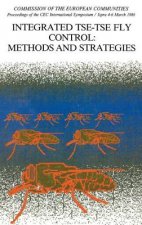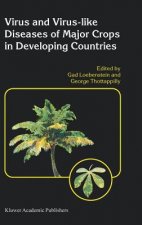
Kód: 01975257
The History of Allelopathy
Autor R.J. Willis
Allelopathy is the study of the chemical interactions of plants. This concept has been known since antiquity, and first appears unambiguously in written form in about 350 B.C. in the works of Theophrastus. This book provides a det ... celý popis
- Jazyk:
 Angličtina
Angličtina - Väzba: Brožovaná
- Počet strán: 316
Nakladateľ: Springer Netherlands, 2010
- Viac informácií o knihe

209.55 €

Skladom u dodávateľa v malom množstve
Odosielame za 12 - 15 dní
Potrebujete viac kusov?Ak máte záujem o viac kusov, preverte, prosím, najprv dostupnosť titulu na našej zákazníckej podpore.
Pridať medzi želanie
Mohlo by sa vám tiež páčiť
-

Rosie
13.56 € -13 % -

Triumph TR6
60.83 € -

Fire
13.06 € -14 % -

Harry Potter and the Prisoner of Azkaban
229.76 € -4 % -

Walden
8.84 € -23 % -

How to Build a Car
36.39 € -2 % -

Read Harder (A Reading Log): Track Books, Chart Progress
17.99 € -

KPI Checklists
36.89 € -

Why Nations Fail
31.77 € -5 % -

Valuation, University Edition, Seventh Edition - Measuring and Managing the Value of Companies
89.08 € -

Blood on the Tracks 5
11.96 € -14 % -

Hospital Dog
8.24 € -28 % -

Stranger Things: Runaway Max
9.95 € -23 % -

Harry Potter and the Chamber of Secrets: MinaLima Edition
29.15 € -18 % -

API Testing and Development with Postman
54.69 € -

House of Sky and Breath
27.64 € -15 % -

What Every BODY is Saying
16.98 € -19 % -

Polski Krok po Kroku. Volume 1: Student's Workbook with free audio download
13.87 € -13 % -

Functional Programming in Scala
45.24 € -

Fairy Tail 2
9.04 € -23 % -

Master Algorithm
11.45 € -19 % -

Coraline
8.24 € -12 % -

The Soviet Chess Primer
25.43 € -1 % -

The Basketball Diaries
13.97 € -23 % -

Fontainebleau Fun Bloc
42.73 € -15 % -

Gnosticism
15.07 € -16 % -

Bulletproof Diet
23.42 € -16 % -

Scientific Advertising
8.54 € -

Eye Movement Disorders (Nystagmus and Strabismus)
140.77 € -12 % -

Speed and Accuracy: Multiplication
8.54 € -

Warriors Super Edition: Bramblestar's Storm
9.44 € -23 % -

Jujutsu Kaisen - Band 14
8.03 € -10 % -

Obchodní korespondence pro střední školy
7.63 € -8 % -

Le Robert Illustre et son Dictionnaire en ligne 2022
40.51 € -

TRILOGIA LA NOVIA GITANA (ESTUCHE)
33.68 € -5 %
Darujte túto knihu ešte dnes
- Objednajte knihu a vyberte Zaslať ako darček.
- Obratom obdržíte darovací poukaz na knihu, ktorý môžete ihneď odovzdať obdarovanému.
- Knihu zašleme na adresu obdarovaného, o nič sa nestaráte.
Viac informácií o knihe The History of Allelopathy
Nákupom získate 527 bodov
 Anotácia knihy
Anotácia knihy
Allelopathy is the study of the chemical interactions of plants. This concept has been known since antiquity, and first appears unambiguously in written form in about 350 B.C. in the works of Theophrastus. This book provides a detailed account of the concept of allelopathy as it has occured through the course of botanical literature from the earliest recorded writings to the modern era.§In the ancient world, the negative and positive interaction of plants was expressed within the framework of antipathy and sympathy of things. As such, antipathy and sympathy were more widely understood than generally appreciated, and indeed were assimilated in aspects of culture outside of botany and agriculture. §This book firstly addresses the question of what is allelopathy, as allelopathy is one of these unfortunate terms in ecology that has no unified definition. The book then examines the major episodes in the history of allelopathy: the writings from classical Greece and Rome; mediaeval Arabic, Indian and Chinese work; the advent of printing and promulgation of information in the 16th and 17th centuries; the 18th century and the theory of root excretion; the 19th century and the influence of A.P. de Candolle; the early 20th century and the work of Pickering and the USDA Bureau of Soils; and the years leading to the current era.§The work draws extensively on original sources, and consequently many of the assertions published in relation to the background of allelopathy, are shown to be incorrect, or at best very inadequate. There is a great deal of information presented, in a consolidated or accessible form, for the first time. The book endeavours to set the history of allelopathy within both a scientific and sociological context.With a claim to be the first work to document in detail the history of allelopathy, Willis s text provides an account of the concept of allelopathy as it has occurred through the course of botanical literature from the earliest recorded writings to the modern era. A great deal of information is presented here in a consolidated and accessible form for the first time. The book offers a unique insight into the historical factors which have influenced the popularity of allelopathy.Allelopathy is the study of the chemical interactions of plants. This concept has been known since antiquity, and first appears unambiguously in written form in about 350 B.C. in the works of Theophrastus. This book gives a detailed account of the concept of allelopathy as it has occurred through the course of botanical literature from the earliest recorded writings to the modern era.§In the ancient world, the negative and positive interaction of plants was expressed within the framework of antipathy and sympathy of things. As such, antipathy and sympathy were more widely understood than generally appreciated, and indeed were assimilated in aspects of culture outside of botany and agriculture.§This book firstly addresses the question of what is allelopathy, as allelopathy is one of these unfortunate terms in ecology that has no unified definition. The book then examines the major episodes in the history of allelopathy: the writings from classical Greece and Rome; mediaeval Arabic, Indian and Chinese work; the advent of printing and promulgation of information in the 16th and 17th centuries; the 18th century and the theory of root excretion; the 19th century and the influence of A.P. de Candolle; the early 20th century and the work of Pickering and the USDA Bureau of Soils; and the years leading to the current era.§The work draws extensively on original sources, and consequently many of the assertions published in relation to the background of allelopathy, are shown to be incorrect, or at best very inadequate. There is a great deal of information presented, in a consolidated or accessible form, for the first time. The book endeavours to set the history of allelopathy within both a scientific and sociological context.
 Parametre knihy
Parametre knihy
Zaradenie knihy Knihy po anglicky Technology, engineering, agriculture Agriculture & farming Pest control
209.55 €
- Celý názov: The History of Allelopathy
- Autor: R.J. Willis
- Jazyk:
 Angličtina
Angličtina - Väzba: Brožovaná
- Počet strán: 316
- EAN: 9789048170395
- ISBN: 9048170397
- ID: 01975257
- Nakladateľ: Springer Netherlands
- Hmotnosť: 473 g
- Rozmery: 240 × 160 × 17 mm
- Rok vydania: 2010
Obľúbené z iného súdka
-

Plant Pathology and Plant Pathogens, Fourth Edition
137.15 € -

How to Get Rid of Garden Pests and Diseases
10.65 € -5 % -

Integrated Pest Management
93.61 € -

RHS Can Anything Stop Slugs?
18.39 € -13 % -

Nicotinoid Insecticides and the Nicotinic Acetylcholine Receptor
272.20 € -

Pest Control Simplified for Everyone
34.68 € -

Non-Chemical Weed Control
56.70 € -

Pesticide Application Methods 4e
279.94 € -

Modern Crop Protection Compounds 3e
600.91 € -

Mites (Acari) for Pest Control
521.78 € -

Insect Pest Management
210.76 € -

Plant Pathology and Plant Pathogens
126.19 € -

Biodiversity and Pest Management in Agroecosystems
106.98 € -

Pests in Houses Great and Small
23.32 € -

Herbicide Resistance and World Grains
319.96 € -

Integrated Pest Management
272.20 € -

Biofouling Methods
257.31 € -

Introduction to Plant Diseases
69.57 € -

Integrated Tse-tse Fly Control
259.12 € -

Natural Control of Garden Pests
20.30 € -12 % -

International code of conduct on pesticide management
15.37 € -

Model Business Plan for a Sterile Insect Production Facility
51.98 € -

Regulating Pesticides in Food
113.12 € -

Weed Biology and Climate Change
234.69 € -

Great Gypsy Moth War
55.30 € -

Fruit Fly Pests
274.31 € -

International Code of Conduct on Pesticide Management
18.79 € -

Climate variability and change
36.99 € -

Pesticide Policy, Production Risk, and Producer Welfare
172.54 € -

Macadamia Integrated Pest Management
23.82 € -

Whitewash
33.07 € -

Nano-Biopesticides Today and Future Perspectives
231.77 € -

Temperature Sensitivity In Insects And Application In Integrated Pest Management
61.33 € -

Chlorinated Insecticides
65.05 € -

Greenhouse Pest Management
266.67 € -

Target Sites of Herbicide Action
875.03 € -

Plant Nematodes of Agricultural Importance
160.18 € -

Pesticide Chemistry
248.36 € -

American Pests
40.41 € -5 % -

Herbicides and Plant Physiology
93.51 € -

Classical Biological Control of Bemisia tabaci in the United States - A Review of Interagency Research and Implementation
137.05 € -

Recognizing and Controlling Nematode Damage in Some Crops Grown in Jamaica
32.77 € -

Insect Outbreaks Revisited
179.28 € -

Biopesticides
106.08 € -

Virus and Virus-like Diseases of Major Crops in Developing Countries
272.20 € -

The History of Allelopathy
210.76 € -

New Approaches to the Economics of Plant Health
272.20 € -

Application Technology for Crop Protection
162.09 € -9 % -

Nematodes as Biocontrol Agents
173.25 € -9 %
Osobný odber Bratislava a 2642 dalších
Copyright ©2008-24 najlacnejsie-knihy.sk Všetky práva vyhradenéSúkromieCookies


 21 miliónov titulov
21 miliónov titulov Vrátenie do mesiaca
Vrátenie do mesiaca 02/210 210 99 (8-15.30h)
02/210 210 99 (8-15.30h)